Hydrothermal synthesis of Bi2Se3 nanosheets by using gallic acid as a reductant†
Abstract
In this work, a simple and reproducible hydrothermal synthesis was employed to synthesize two-dimensional Bi2Se3 nanosheets by using gallic acid as a reductant. Meanwhile, the effects of the amounts of gallic acid and sodium hydroxide and the surfactant Triton X-100 on phase composition and morphology of the obtained Bi2Se3 were also studied. The results reveal that gallic acid could effectively reduce Se4+ to Se2− and gave rise to the formation of Bi2Se3. Additionally, keeping the reaction conditions of molar ratio of gallic acid to the precursor elements (Bi + Se) at 1 to 1 (or higher) and using strong alkaline solutions were the key factors to synthesize high purity crystalline Bi2Se3 nanosheets. Furthermore, flower-like Bi2Se3 composed of nanosheets with a dozen nanometer thickness could be easily fabricated by adding appropriate amounts of Triton X-100. This work provides a novel approach for synthesis of ultra-thin Bi2Se3 nanosheets in a controllable manner.



 Please wait while we load your content...
Please wait while we load your content...